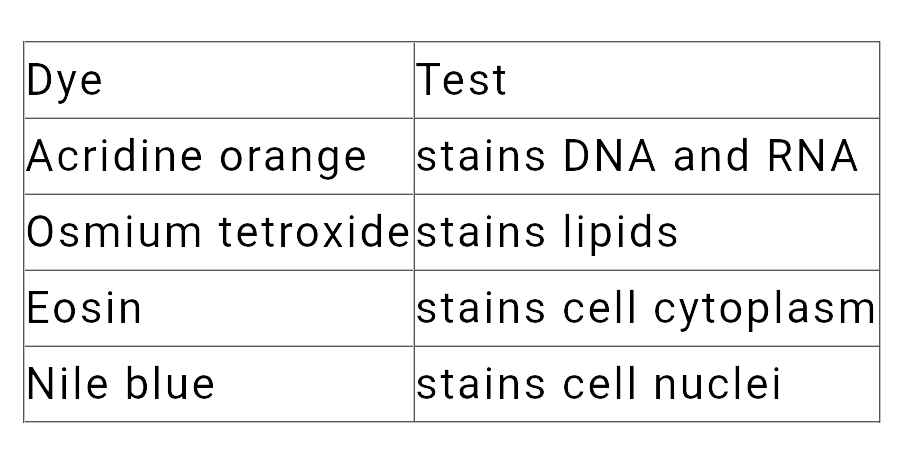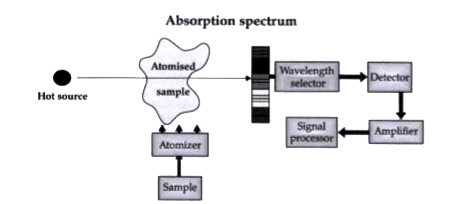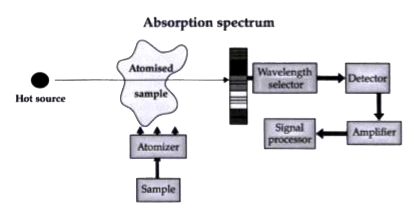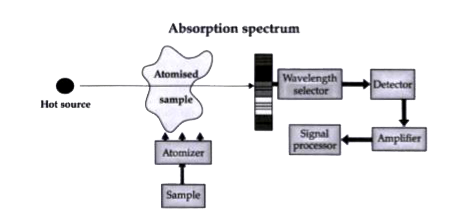A sample was given to the lab technician for figuring out whether the cells of the sample come under the category of prokaryote or eukaryote . Four of the dyes are described in the determining process .

Predict the stain that was used by the lab technician that help her identify whether sample cells will come under the group of prokaryote or eukaryote.
Acridine orange
Eosin
Nile blue
Osmium tetroxide
The correct Answer is:C
Step by step video & image solution for A sample was given to the lab technician for figuring out whether the cells of the sample come under the category of prokaryote or eukaryote . Four of the dyes are described in the determining process . Predict the stain that was used by the lab technician that help her identify whether sample cells will come under the group of prokaryote or eukaryote. by Biology experts to help you in doubts & scoring excellent marks in Class 12 exams.
Updated on:21/07/2023Topper's Solved these Questions
Similar Questions
Read the following text and answer the following questions on the basis of the same:
Atomic Absorption Spectrometer: The atomic absorption (AA) spectrometer is used to analyze metals at very low concentrations, typically in the parts per million (ppm) or parts per billion (ppb) ranges. A liquid sample containing dissolved material whose concentration is to be measured is aspirated into a thin, wide AA flame, or is introduced into a small carbon furnace which is heated to a high temperature.

Basic Principle of AAS is the measurement of absorption of radiation by free atoms. The total amount of absorption depends on the number of free atoms present and the degreee to which the free atoms absorb the radiation. At the high temperature of the AA flame, the sample is broken down into atoms using an atomizer and it is the concentration of these atoms that is measured. Sample in the form of solution is used. It is broken up into a fine mist with the help of an atomizer. When the mist reaches the flame, the intense heat breaks up the sample into its individual atoms. When a photon coming out from the hot source hits an atom and the energy of the photon is equal to the gap between two electron energy levels of the atom, then the electron in the lower energy level absorb the photon and jumps up to the higher energy level. If the photon energy does not correspond to the difference between two energy levels, then the photon will not be absorbed (it may be scattered away). Hence in the spectrum, the wavelength corresponding to the absorbed photons is observed as black lines as shown in the following spectrum of Hydrogen. The dark lines correspon to the frequencies of light those have been absorbed by the sample element. Using this process, a source of photons (generally a white light) of various energies is used to obtain the absorption spectra of different materials and to identify them.
What should be the concentration of metal for analysis using Atomic Absorption Spectrometer?
View SolutionRead the passage carefully and answer the question given below:
Who would have thought that every squeal, squeak and chirp that comes out of the mouth of the humble Gunnison Prairie dog means something ? A three-decade study of these rodents has revealed a language so complex, that is surpasses the communication skills of dolphins, whales and even non-human primates like monkeys!
The stunning findings were revealed by Professor Con Slobodchikoff, who has been recording
The smart little rodents use their words to identify not only who the predator is, i.e. a coyote , human , dog, or a particular kind of bird, but also details like their shape, size color and even the pace at which they are approaching.
To conduct his research, the professor and a number of students from Northern Arizona University, hid inside the prairie dog villages and recorded all the sounds they made. What the team discovered is that these smart creatures are able alert their entire group of many details, (the predator, its color, location, etc.) by sounding just one single 'word'. They do that by modulating or varying the pitch of their voice.
What was also interesting is how the animals responded to each kind of predator. In the case of a coyote, they quickly scampered into their burrows, while for badgers, they simply laid low, to avoid being spotted.
To test their theories, the scientist played back some of the recorded sounds, as well as, asked four volunteers to walk into the prairie village, wearing a different coloured shirt each time, the rodents reacted exactly the same way they had in the presence of the real predator, confirming that the animal had not only conveyed that the predator was a human, but also, whether he/she was fat/thin and the color of the shirt ! Simple fascinating!
While dubbed dogs, thanks to their canine-like barks, Prairie dogs are actually ground dwelling squirrels and part of the rodent family, which includes not only rats and mice, but also, porcupines and beavers. The Gunnison, found primarily in North America, is one of five species that is alive today.
By Meera Dolasia
Question : How did the team study and know more about the rodents ?
View Solution
Knowledge Check
Read the following text and answer the following questions on the basis of the same:
Atomic Absorption Spectrometer: The atomic absorption (AA) spectrometer is used to analyze metals at very low concentrations, typically in the parts per million (ppm) or parts per billion (ppb) ranges. A liquid sample containing dissolved material whose concentration is to be measured is aspirated into a thin, wide AA flame, or is introduced into a small carbon furnace which is heated to a high temperature.

Basic Principle of AAS is the measurement of absorption of radiation by free atoms. The total amount of absorption depends on the number of free atoms present and the degreee to which the free atoms absorb the radiation. At the high temperature of the AA flame, the sample is broken down into atoms using an atomizer and it is the concentration of these atoms that is measured. Sample in the form of solution is used. It is broken up into a fine mist with the help of an atomizer. When the mist reaches the flame, the intense heat breaks up the sample into its individual atoms. When a photon coming out from the hot source hits an atom and the energy of the photon is equal to the gap between two electron energy levels of the atom, then the electron in the lower energy level absorb the photon and jumps up to the higher energy level. If the photon energy does not correspond to the difference between two energy levels, then the photon will not be absorbed (it may be scattered away). Hence in the spectrum, the wavelength corresponding to the absorbed photons is observed as black lines as shown in the following spectrum of Hydrogen. The dark lines correspon to the frequencies of light those have been absorbed by the sample element. Using this process, a source of photons (generally a white light) of various energies is used to obtain the absorption spectra of different materials and to identify them.
What happens when a photon hits an atom and the energy of the photon is not equal to the gap between two electron energy levels of the atom?AThe photon is absorbed and the electron moves to an intermediate energy level.BThe photon is absorbed and the electron gets scatteredCThe photon is not absorbed. It gets scattered.DNone of the aboveRead the following text and answer the following questions on the basis of the same:
Atomic Absorption Spectrometer: The atomic absorption (AA) spectrometer is used to analyze metals at very low concentrations, typically in the parts per million (ppm) or parts per billion (ppb) ranges. A liquid sample containing dissolved material whose concentration is to be measured is aspirated into a thin, wide AA flame, or is introduced into a small carbon furnace which is heated to a high temperature.

Basic Principle of AAS is the measurement of absorption of radiation by free atoms. The total amount of absorption depends on the number of free atoms present and the degreee to which the free atoms absorb the radiation. At the high temperature of the AA flame, the sample is broken down into atoms using an atomizer and it is the concentration of these atoms that is measured. Sample in the form of solution is used. It is broken up into a fine mist with the help of an atomizer. When the mist reaches the flame, the intense heat breaks up the sample into its individual atoms. When a photon coming out from the hot source hits an atom and the energy of the photon is equal to the gap between two electron energy levels of the atom, then the electron in the lower energy level absorb the photon and jumps up to the higher energy level. If the photon energy does not correspond to the difference between two energy levels, then the photon will not be absorbed (it may be scattered away). Hence in the spectrum, the wavelength corresponding to the absorbed photons is observed as black lines as shown in the following spectrum of Hydrogen. The dark lines correspon to the frequencies of light those have been absorbed by the sample element. Using this process, a source of photons (generally a white light) of various energies is used to obtain the absorption spectra of different materials and to identify them.
What is the basic principle of Atomic Absorption Spectrophotometer?AEmission of photons when excited electron of an atom comes back to lower energy level.BAbsorption of photons when electrons at lower energy level jumps to a higher energy level.CEmission of electrons from an atom at a very high temperature.DEmission of electron when energetic photons bombard an atom.Read the following text and answer the following questions on the basis of the same:
Atomic Absorption Spectrometer: The atomic absorption (AA) spectrometer is used to analyze metals at very low concentrations, typically in the parts per million (ppm) or parts per billion (ppb) ranges. A liquid sample containing dissolved material whose concentration is to be measured is aspirated into a thin, wide AA flame, or is introduced into a small carbon furnace which is heated to a high temperature.

Basic Principle of AAS is the measurement of absorption of radiation by free atoms. The total amount of absorption depends on the number of free atoms present and the degreee to which the free atoms absorb the radiation. At the high temperature of the AA flame, the sample is broken down into atoms using an atomizer and it is the concentration of these atoms that is measured. Sample in the form of solution is used. It is broken up into a fine mist with the help of an atomizer. When the mist reaches the flame, the intense heat breaks up the sample into its individual atoms. When a photon coming out from the hot source hits an atom and the energy of the photon is equal to the gap between two electron energy levels of the atom, then the electron in the lower energy level absorb the photon and jumps up to the higher energy level. If the photon energy does not correspond to the difference between two energy levels, then the photon will not be absorbed (it may be scattered away). Hence in the spectrum, the wavelength corresponding to the absorbed photons is observed as black lines as shown in the following spectrum of Hydrogen. The dark lines correspon to the frequencies of light those have been absorbed by the sample element. Using this process, a source of photons (generally a white light) of various energies is used to obtain the absorption spectra of different materials and to identify them.
How the sample for analysis is deriven to atomic state in AAS?AAt a very high temperature, the sample is driven to its gaseous stateBUsing an atomizer and then intense heatingCBy rotating the solution of the sample at a very high speed.DNone of the above
Read the passage carefully and answer the question given below:
Who would have thought that every squeal, squeak and chirp that comes out of the mouth of the humble Gunnison Prairie dog means something ? A three-decade study of these rodents has revealed a language so complex, that is surpasses the communication skills of dolphins, whales and even non-human primates like monkeys!
The stunning findings were revealed by Professor Con Slobodchikoff, who has been recording
The smart little rodents use their words to identify not only who the predator is, i.e. a coyote , human , dog, or a particular kind of bird, but also details like their shape, size color and even the pace at which they are approaching.
To conduct his research, the professor and a number of students from Northern Arizona University, hid inside the prairie dog villages and recorded all the sounds they made. What the team discovered is that these smart creatures are able alert their entire group of many details, (the predator, its color, location, etc.) by sounding just one single 'word'. They do that by modulating or varying the pitch of their voice.
What was also interesting is how the animals responded to each kind of predator. In the case of a coyote, they quickly scampered into their burrows, while for badgers, they simply laid low, to avoid being spotted.
To test their theories, the scientist played back some of the recorded sounds, as well as, asked four volunteers to walk into the prairie village, wearing a different coloured shirt each time, the rodents reacted exactly the same way they had in the presence of the real predator, confirming that the animal had not only conveyed that the predator was a human, but also, whether he/she was fat/thin and the color of the shirt ! Simple fascinating!
While dubbed dogs, thanks to their canine-like barks, Prairie dogs are actually ground dwelling squirrels and part of the rodent family, which includes not only rats and mice, but also, porcupines and beavers. The Gunnison, found primarily in North America, is one of five species that is alive today.
By Meera Dolasia
Question : In the passage, the writer say that these animals were "dubbed dogs" because they:
View SolutionRead the passage carefully and answer the question given below:
Who would have thought that every squeal, squeak and chirp that comes out of the mouth of the humble Gunnison Prairie dog means something ? A three-decade study of these rodents has revealed a language so complex, that is surpasses the communication skills of dolphins, whales and even non-human primates like monkeys!
The stunning findings were revealed by Professor Con Slobodchikoff, who has been recording
The smart little rodents use their words to identify not only who the predator is, i.e. a coyote , human , dog, or a particular kind of bird, but also details like their shape, size color and even the pace at which they are approaching.
To conduct his research, the professor and a number of students from Northern Arizona University, hid inside the prairie dog villages and recorded all the sounds they made. What the team discovered is that these smart creatures are able alert their entire group of many details, (the predator, its color, location, etc.) by sounding just one single 'word'. They do that by modulating or varying the pitch of their voice.
What was also interesting is how the animals responded to each kind of predator. In the case of a coyote, they quickly scampered into their burrows, while for badgers, they simply laid low, to avoid being spotted.
To test their theories, the scientist played back some of the recorded sounds, as well as, asked four volunteers to walk into the prairie village, wearing a different coloured shirt each time, the rodents reacted exactly the same way they had in the presence of the real predator, confirming that the animal had not only conveyed that the predator was a human, but also, whether he/she was fat/thin and the color of the shirt ! Simple fascinating!
While dubbed dogs, thanks to their canine-like barks, Prairie dogs are actually ground dwelling squirrels and part of the rodent family, which includes not only rats and mice, but also, porcupines and beavers. The Gunnison, found primarily in North America, is one of five species that is alive today.
By Meera Dolasia
Question : According to the passage, for how long had the study on the animal been conducted ?
View SolutionRead the passage carefully and answer the question given below:
Who would have thought that every squeal, squeak and chirp that comes out of the mouth of the humble Gunnison Prairie dog means something ? A three-decade study of these rodents has revealed a language so complex, that is surpasses the communication skills of dolphins, whales and even non-human primates like monkeys!
The stunning findings were revealed by Professor Con Slobodchikoff, who has been recording
The smart little rodents use their words to identify not only who the predator is, i.e. a coyote , human , dog, or a particular kind of bird, but also details like their shape, size color and even the pace at which they are approaching.
To conduct his research, the professor and a number of students from Northern Arizona University, hid inside the prairie dog villages and recorded all the sounds they made. What the team discovered is that these smart creatures are able alert their entire group of many details, (the predator, its color, location, etc.) by sounding just one single 'word'. They do that by modulating or varying the pitch of their voice.
What was also interesting is how the animals responded to each kind of predator. In the case of a coyote, they quickly scampered into their burrows, while for badgers, they simply laid low, to avoid being spotted.
To test their theories, the scientist played back some of the recorded sounds, as well as, asked four volunteers to walk into the prairie village, wearing a different coloured shirt each time, the rodents reacted exactly the same way they had in the presence of the real predator, confirming that the animal had not only conveyed that the predator was a human, but also, whether he/she was fat/thin and the color of the shirt ! Simple fascinating!
While dubbed dogs, thanks to their canine-like barks, Prairie dogs are actually ground dwelling squirrels and part of the rodent family, which includes not only rats and mice, but also, porcupines and beavers. The Gunnison, found primarily in North America, is one of five species that is alive today.
By Meera Dolasia
Question : Which one of the following statements is TRUE according to the passage ?
View SolutionRead the passage carefully and answer the question given below:
Who would have thought that every squeal, squeak and chirp that comes out of the mouth of the humble Gunnison Prairie dog means something ? A three-decade study of these rodents has revealed a language so complex, that is surpasses the communication skills of dolphins, whales and even non-human primates like monkeys!
The stunning findings were revealed by Professor Con Slobodchikoff, who has been recording
The smart little rodents use their words to identify not only who the predator is, i.e. a coyote , human , dog, or a particular kind of bird, but also details like their shape, size color and even the pace at which they are approaching.
To conduct his research, the professor and a number of students from Northern Arizona University, hid inside the prairie dog villages and recorded all the sounds they made. What the team discovered is that these smart creatures are able alert their entire group of many details, (the predator, its color, location, etc.) by sounding just one single 'word'. They do that by modulating or varying the pitch of their voice.
What was also interesting is how the animals responded to each kind of predator. In the case of a coyote, they quickly scampered into their burrows, while for badgers, they simply laid low, to avoid being spotted.
To test their theories, the scientist played back some of the recorded sounds, as well as, asked four volunteers to walk into the prairie village, wearing a different coloured shirt each time, the rodents reacted exactly the same way they had in the presence of the real predator, confirming that the animal had not only conveyed that the predator was a human, but also, whether he/she was fat/thin and the color of the shirt ! Simple fascinating!
While dubbed dogs, thanks to their canine-like barks, Prairie dogs are actually ground dwelling squirrels and part of the rodent family, which includes not only rats and mice, but also, porcupines and beavers. The Gunnison, found primarily in North America, is one of five species that is alive today.
By Meera Dolasia
Question : A suitable title for the passage could be :
View SolutionRead the passage carefully and choose the best answer to each question out of the four alternatives and click the button corresponding to it.
It.s nothing short of a revolution in how we eat, and it.s getting closer every day. Yes, a lot of people are obese, and yes, the definition of ..healthy eating.. seems to change all the time. But in labs and research centres around the world, scientists are racing to match our genes and our taste buds, creating the perfect diet for each of us, a diet that will fight disease, increase longevity, boost physical and mental performance, and taste great to boot. As food scientist J.Bruce German says, ..The foods we like the most will be the most healthy for us."
Is that going to be a great day, or what?
All this will come to pass, thanks to genomics, the science that maps and describes an individual.s genetic code. In the future, personalized DNA chips will allow us to assess our own inherited predispositions for certain diseases, then adjust our diets accordingly. So, if you.re at risk for heart disease, you won.t just go on a generic low-fat diet. You.ll eat foods with just the right amount and type of fat that.s best for you. You.ll even be able to track your metabolism day-to-day to determine what foods you should eat at any given time, for any given activity. ..Since people differ in their genetics and metabolism, one diet won.t fit all," says German.
As complex as all this sounds, it could turn out to be relatively simple.
What does J. Bruce German say?
View Solution
